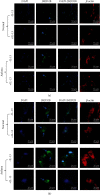IL-13 Augments Histone Demethylase JMJD2B/KDM4B Expression Levels, Activity, and Nuclear Translocation in Airway Fibroblasts in Asthma
- PMID: 33688506
- PMCID: PMC7920726
- DOI: 10.1155/2021/6629844
IL-13 Augments Histone Demethylase JMJD2B/KDM4B Expression Levels, Activity, and Nuclear Translocation in Airway Fibroblasts in Asthma
Abstract
Purpose: Asthma is one of the most common obstructive pulmonary diseases worldwide. Epigenetic alterations, including DNA methylation and histone modifications, have been reported to contribute to asthma pathogenesis. Since the inflammation mediator and remodeling trigger, IL-13, is known to play a central role in the pathophysiology of asthma, this study was aimed to identify novel IL-13-regulated epigenetic modifiers in asthma that may contribute to subepithelial fibrosis.
Methods: Publicly available transcriptomic datasets from Gene Expression Omnibus (GEO) were used to identify differentially expressed genes on an epigenetic level upon IL-13 exposure in lung fibroblasts. Bronchial fibroblasts isolated from healthy and asthmatic individuals were assessed for the gene and protein expression levels of the identified gene at baseline and upon IL-13 treatment using qRT-PCR and western blotting, respectively. Its subcellular localization and tissue distribution were examined in bronchial fibroblasts as well as bronchial biopsies by immunofluorescence and immunohistochemical analysis, respectively.
Results: Bioinformatic analysis revealed the differential expression of the histone demethylase JMJD2B/KDM4B, a well-known epigenetic modulator that leads to the demethylation of different lysine residues on histones, in IL-13-treated lung fibroblasts. The baseline expression levels of JMJD2B were higher in asthmatic fibroblasts and in bronchial biopsies in comparison to healthy ones. There was also an increase in JMJD2B activity as evidenced by the demethylation of its downstream target, H3K36me3. Furthermore, IL-13 stimulation induced JMJD2B expression and further demethylation of H3K36me3 in asthmatic fibroblasts. This was accompanied by increased translocation of JMJD2B into the nucleus.
Conclusion: This study highlights the novel pathological involvement of the histone demethylase JMJD2B/KDM4B in asthmatic airway fibroblasts that are regulated by IL-13. Clinical implications. Given that there is no single therapeutic medicine to effectively treat the various subtypes of asthma, this study provides promising insights into JMJD2B as a new therapeutic target that could potentially improve the treatment and management of asthma.
Copyright © 2021 Khuloud Bajbouj et al.
Conflict of interest statement
The authors declare that there is no conflict of interest.
Figures





Similar articles
-
The histone demethylase JMJD2B plays an essential role in human carcinogenesis through positive regulation of cyclin-dependent kinase 6.Cancer Prev Res (Phila). 2011 Dec;4(12):2051-61. doi: 10.1158/1940-6207.CAPR-11-0290. Epub 2011 Sep 19. Cancer Prev Res (Phila). 2011. PMID: 21930796
-
Histone H3K9 demethylase JMJD2B/KDM4B promotes osteogenic differentiation of bone marrow-derived mesenchymal stem cells by regulating H3K9me2 on RUNX2.PeerJ. 2022 Oct 5;10:e13862. doi: 10.7717/peerj.13862. eCollection 2022. PeerJ. 2022. PMID: 36217382 Free PMC article.
-
Histone demethylase JMJD2B/KDM4B regulates transcriptional program via distinctive epigenetic targets and protein interactors for the maintenance of trophoblast stem cells.Sci Rep. 2021 Jan 13;11(1):884. doi: 10.1038/s41598-020-79601-7. Sci Rep. 2021. PMID: 33441614 Free PMC article.
-
Epigenetic gene regulation by plant Jumonji group of histone demethylase.Biochim Biophys Acta. 2011 Aug;1809(8):421-6. doi: 10.1016/j.bbagrm.2011.03.004. Epub 2011 Mar 16. Biochim Biophys Acta. 2011. PMID: 21419882 Review.
-
The role of demethylases in cardiac development and disease.J Mol Cell Cardiol. 2021 Sep;158:89-100. doi: 10.1016/j.yjmcc.2021.05.018. Epub 2021 May 31. J Mol Cell Cardiol. 2021. PMID: 34081951 Review.
Cited by
-
The Role of Systems Biology in Deciphering Asthma Heterogeneity.Life (Basel). 2022 Oct 8;12(10):1562. doi: 10.3390/life12101562. Life (Basel). 2022. PMID: 36294997 Free PMC article. Review.
-
Histone demethylases in the regulation of immunity and inflammation.Cell Death Discov. 2023 Jun 23;9(1):188. doi: 10.1038/s41420-023-01489-9. Cell Death Discov. 2023. PMID: 37353521 Free PMC article. Review.
-
KDM4B: A promising oncology therapeutic target.Cancer Sci. 2024 Jan;115(1):8-16. doi: 10.1111/cas.16005. Epub 2023 Nov 3. Cancer Sci. 2024. PMID: 37923555 Free PMC article. Review.
-
Pulmonary inflammation and fibroblast immunoregulation: from bench to bedside.J Clin Invest. 2023 Sep 1;133(17):e170499. doi: 10.1172/JCI170499. J Clin Invest. 2023. PMID: 37655660 Free PMC article. Review.
-
Strategies Targeting Type 2 Inflammation: From Monoclonal Antibodies to JAK-Inhibitors.Biomedicines. 2021 Oct 19;9(10):1497. doi: 10.3390/biomedicines9101497. Biomedicines. 2021. PMID: 34680614 Free PMC article. Review.
References
-
- Firszt R., Francisco D., Church T. D., Thomas J. M., Ingram J. L., Kraft M. Interleukin-13 induces collagen type-1 expression through matrix metalloproteinase-2 and transforming growth factor-β1 in airway fibroblasts in asthma. The European respiratory journal. 2014;43(2):464–473. doi: 10.1183/09031936.00068712. - DOI - PMC - PubMed
MeSH terms
Substances
LinkOut - more resources
Full Text Sources
Other Literature Sources
Medical

